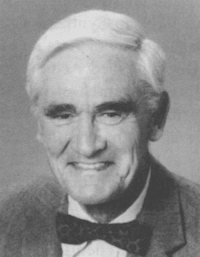Donald J. Cram
1919 – 2001
Donald J. Cram, professor at UCLA for 54 years and member of the advisory board of Organic Reactions, died of cancer June 17 at the age of 82.
Don was born in Vermont and developed an interest in Chemistry about the 12th grade. He received his B.S. degree from Rollins College in 1941 and M.S. degree from the University of Nebraska in 1942. During the period 1942-1945, he was a Research Chemist at Merck & Co., where he worked on penicillin. Don received his Ph.D. degree in 1947 from Harvard University, where he was a student of Louis Fieser. At Rollins College, his first chemistry professor told him that he would make a good industrial researcher, but probably not a good academic one. Thereafter, Don Cram resolved to pursue an academic career in chemistry!
After a short postdoctoral with J. D. Roberts as an American Chemical Society (ACS) fellow, Don joined the UCLA faculty in 1947 as an instructor, and was promoted to Professor in 1957. During his career at UCLA he taught organic chemistry to many thousands of undergraduates. His textbook (with George Hammond) caused a revolution in the teaching of organic chemistry. It introduced students worldwide to learning the subject in a rational manner according to reaction types and introduced concepts such as mechanisms and orbitals for the first time in a systematic manner. “Cram and Hammond” was a refreshing wind of change for those studying chemistry in the 1960s.
Don mentored about 120 Ph.D. students and 100 postdoctoral research associates, and authored more than 400 papers and seven books. For the last 25 years of his career, he worked in and defined the field of host-guest chemistry. Before that, he made major contributions to the areas of phenonium ions, asymmetric induction, carbanions, paracyclophanes, and the use of stereochemistry for elucidating reaction mechanisms. Cram’s rule (governing asymmetric induction) was defined just 50 years ago, and has had a major impact on the subsequent development of asymmetric synthesis and catalysis.
Don was elected to the National Academy of Sciences in 1961 and received the ACS Award for Creative Work in Synthetic Organic Chemistry in 1965. He was elected to the American Academy of Arts and Sciences in 1967. He received the ACS Cope Award for Distinguished Achievement in Organic Chemistry in 1974 and was named California Scientist of the Year in the same year. He received the Southern California ACS Tolman Award and the Chicago Section ACS Gibbs Medal in 1985 and was named the first holder of the Saul Winstein Chair in Organic Chemistry at UCLA in the same year. He received the American Chemical Society’s top award in organic chemistry, the Roger Adams Award, in 1985. In 1987, he was awarded the Nobel Prize in Chemistry with Charles Pedersen (United States) and Jean-Marie Lehn (France) for his role in developing and defining host-guest chemistry, the conceptual revolution that took chemistry beyond the molecular level. He was named University of California University Professor in 1988 and received the National Academy of Sciences Award in Chemical Sciences in 1992. He received the National Medal of Science from President Clinton in 1993. Don held honorary degrees from Uppsala University, Sweden (1977), the University of Southern California (1983), Rollins College (1988), the University of Nebraska (1989), the University of Western Ontario, Canada (1989), and the University of Sheffield, U.K. (1991).
Cram’s host-guest chemistry, as he christened it, has led to a science that is now being pursued on the nanometer scale all around the world. This chemistry harnesses the cooperative power of weak interactions that fall under the umbrella of “noncovalent” chemical bonds. Although host-guest chemistry uses unnatural chemical compounds, Don was inspired by a desire to mimic Nature’s catalysts, the enzymes. As he developed his own brand of chemistry, he turned his flair for design and synthesis more and more to the abstract and produced a vast array of novel container molecules, inventing and building new series of compounds with names like spherands, cavitands, and carcerands.
Don felt his way onto this new chemical landscape by playing with space-filling molecular models made of plastic (so-called CPK models). Anyone who knew Don from 1970 onwards will have a lasting image of him with the sack of CPK models that accompanied him everywhere. The awesome dexterity with which he could construct models of unnatural molecules preorganized to encircle or engulf other molecules and ions was only surpassed by the synthetic wizardry that produced the real artificial hosts to match actual guests, both big and small.
Don was a surfer (he belonged to the San Onofre Surfing Club “Old Guys”), a tennis player, and a skier. He also liked to sing folk songs and accompany himself on the guitar, which he often did for large classes of undergraduate organic chemistry students. Don was a pivotal figure in the development of the UCLA Chemistry and Biochemistry Department throughout the latter half of the twentieth century. He held himself and others to the highest standards.
Don is survived by his wife, Caroline.
Christopher S. Foote
J. Fraser Stoddart


